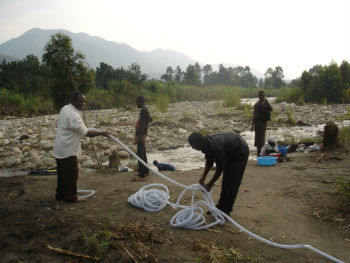Sowing seeds on sandy soil
When floods devastated a community in Uganda, BMS responded. A few months on we are helping them move forward.
“I’ve never been anywhere where there has been flooding before. It took a while to get my

head around the fact that the river I was looking at wasn’t even the original river.”
Gareth Shrubsole, a BMS World Mission worker in Western Uganda, was taken aback by the devastation he saw in Kasese district when heavy rains brought flooding on 1 May 2013.
“We were standing there looking at a river that looked like it had been there for hundreds of years but which had previously been farmland and people’s gardens. The magnitude of what happened was really quite difficult to take in.”
Thanks to a BMS Disaster Recovery Grant and funding from two other Christian charities, Gareth, along with his wife Bethan and Baptist minister Pastor Alfonse, were able to supply blankets to 75 families in the Congo Quarter who had been cut off by the floods and had been overlooked by other aid agencies.
When he saw the amount of sand left on people’s farm land it became apparent to Gareth that the people would need more help.
“We dug through the sand to try to reach the soil in places and at one point I could stand waist deep in sand with my feet on the original soil. It became obvious that you couldn’t just give this community a sticking plaster and tell them to get back on their feet. They were never going to grow that land again with traditional African growing methods.”
Gareth did extensive research into how the families would be able to grow crops on the land again. After two months he found a solution – digging targeted holes, adding animal dung as compost and irrigating the soil with water pumped from the river, would allow plants to grow.
At the end of August Gareth did some training in the Congo Quarter, sharing with the locals how to get the best out of the sandy soil. Once they had cleared their land, they would be given seeds to sow and access to hip pumps to irrigate the soil. The pumps were paid for by another grant from BMS Disaster Recovery Appeal.
So two months on, what is happening? Has the plan worked?
“Some people have taken the advice absolutely and for a few their gardens are thriving,” says Gareth. “They’ve got good nursery beds, they’ve managed to maximise the good soil where they could find it and they have got plants growing.
“A few didn’t take the advice on board, tried to plant tomato seeds directly into the sand and those seeds haven’t germinated.”
One of the best gardens has been grown by a Christian. Gareth and Pastor Alex, from the nearby Baptist church, are trying to encourage him that this could be a great opportunity to witness to his neighbours.
“We have been talking to him and trying to get him to help his neighbours and see that, as a Christian, that a way he can practically love his neighbour is to help them farm, help them use the pump and use the right planting methods so they can get a garden that looks like his.”
Gareth is encouraged by the progress so far and definitely feels it is an improvement on doing nothing. It is a tough project in a tough area and whilst some will benefit, others will still be suffering. For instance heavy rains recently led to a slight overflow of the river which resulted in some seeds that had been growing well, being swept away. Gareth is asking us to pray for the project.
“Pray we can work through the challenges of this project. Pray that the success of some gardens will not cause jealously or division but will be a positive sign of Christians helping their neighbours. Pray that through that there will be better relations in the community and between the community and the Church.”
How it works:
The traditional African farming method of growing a row of seeds will not work due to the amount of sand now on the land in Congo Quarter. BMS mission worker, Alex Vickers, who is doing agricultural work in the north of Uganda, advised Gareth that the digging of targeted holes where a mixture of sand, soil and some animal dung as compost would produce something you could grow a plant in.
Such sandy soil will not retain rain water very well so using the river as irrigation appeared to be the solution. After the floods the river had gone through a nearby copper mine meaning there was a risk the water had been contaminated. Alex did some soil sampling which confirmed the soil was clean.
Gareth then researched how to pump the water from the river to the crops. He had some helpful Skype conversations with a Christian retired water engineer, Richard Cansdale, who had worked with ‘rower pumps’ in Nigeria and Bangladesh in the 1970s and 80s. Gareth was then able to find a newer version of the rower pump manufactured in Kenya. The BMS Disaster Recovery Appeal gave a grant to buy the pumps in time for the planting season.
This article first appeared on the website of BMS World Mission and is used with permission